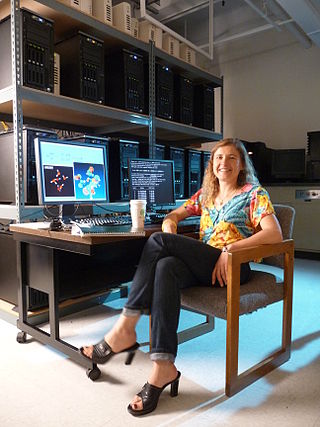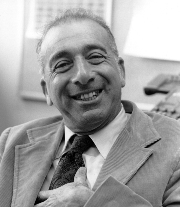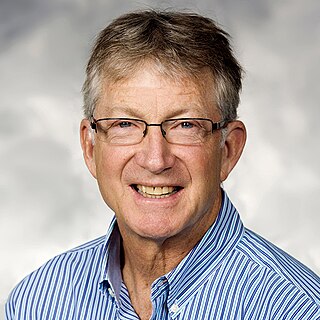
Kenneth Geddes "Ken" Wilson was an American theoretical physicist and a pioneer in leveraging computers for studying particle physics. He was awarded the 1982 Nobel Prize in Physics for his work on phase transitions—illuminating the subtle essence of phenomena like melting ice and emerging magnetism. It was embodied in his fundamental work on the renormalization group.

Peter V. Coveney is a British chemist who is Professor of Physical Chemistry, Honorary Professor of Computer Science, and the Director of the Centre for Computational Science (CCS) and Associate Director of the Advanced Research Computing Centre at University College London (UCL). He is also a Professor of Applied High Performance Computing at University of Amsterdam (UvA) and Professor Adjunct at the Yale School of Medicine, Yale University. He is a Fellow of the Royal Academy of Engineering and Member of Academia Europaea.

Denis James Evans, is an Australian scientist who is an Emeritus Professor at the Australian National University and Honorary Professor at The University of Queensland. He is widely recognised for his contributions to nonequilibrium thermodynamics and nonequilibrium statistical mechanics and the simulation of nonequilibrium fluids.
Michael Ellis Fisher was an English physicist, as well as chemist and mathematician, known for his many seminal contributions to statistical physics, including but not restricted to the theory of phase transitions and critical phenomena. He was the Horace White Professor of Chemistry, Physics, and Mathematics at Cornell University. Later he moved to the University of Maryland College of Computer, Mathematical, and Natural Sciences, where he was University System of Maryland Regents Professor, a Distinguished University Professor and Distinguished Scholar-Teacher.
The Boltzmann Medal is a prize awarded to physicists that obtain new results concerning statistical mechanics; it is named after the celebrated physicist Ludwig Boltzmann. The Boltzmann Medal is awarded once every three years by the Commission on Statistical Physics of the International Union of Pure and Applied Physics, during the STATPHYS conference.

Anna Igorevna Krylov is the USC Associates Chair in Natural Sciences and Professor of Chemistry at the University of Southern California (USC). Working in the field of theoretical and computational quantum chemistry, she is the inventor of the spin-flip method. Krylov is the president of Q-Chem, Inc. and an elected member of the International Academy of Quantum Molecular Science, the Academia Europaea, and the American Academy of Sciences and Letters.
The Widom insertion method is a statistical thermodynamic approach to the calculation of material and mixture properties. It is named for Benjamin Widom, who derived it in 1963. In general, there are two theoretical approaches to determining the statistical mechanical properties of materials. The first is the direct calculation of the overall partition function of the system, which directly yields the system free energy. The second approach, known as the Widom insertion method, instead derives from calculations centering on one molecule. The Widom insertion method directly yields the chemical potential of one component rather than the system free energy. This approach is most widely applied in molecular computer simulations but has also been applied in the development of analytical statistical mechanical models. The Widom insertion method can be understood as an application of the Jarzynski equality since it measures the excess free energy difference via the average work needed to perform, when changing the system from a state with N molecules to a state with N+1 molecules. Therefore it measures the excess chemical potential since , where .

Berni Julian Alder was a German-born American physicist specialized in statistical mechanics, and a pioneer of computational modelling of matter.
The Onsager Medal (Onsagermedaljen) is a scholastic presentation awarded to researchers in one or more subject areas of chemistry, physics or mathematics. The medal is awarded in memory of Lars Onsager, who received Nobel Prize in Chemistry in 1968. The medal, designed by Harald Wårvik, commemorates the efforts of a single individual as chosen by the Onsager committee at the Norwegian University of Science and Technology (NTNU). The professorship awardee is expected to spend 3–6 months working at NTNU. The lectureship awardee will give a lecture at the university.
Marie-Paule Pileni is a French physical chemist who was born in Tananarive, Madagascar. She is an Emeritus Professor at Sorbonne University and a Senior Member, since 1999, and administrator (2004–2011) of the Institut Universitaire de France.

Renato Zenobi is a Swiss chemist. He is Professor of Chemistry at ETH Zurich. Throughout his career, Zenobi has contributed to the field of analytical chemistry.

Jack H. Freed is an American chemist known for his pioneering work in electron paramagnetic resonance spectroscopy. He is the Frank and Robert Laughlin Professor of Physical Chemistry, emeritus, at Cornell University in Ithaca, New York.
John Isaiah Brauman is an American chemist.

Julia Mary Yeomans is a British theoretical physicist active in the fields of soft condensed matter and biological physics. She has served as Professor of Physics at the University of Oxford since 2002.

Bidyendu Mohan Deb is an Indian theoretical chemist, chemical physicist and a professor at the Indian Institute of Science Education and Research, Kolkata (IISER). he is known for his studies in theoretical chemistry and chemical physics. He is an elected fellow of the International Union of Pure and Applied Chemistry, The World Academy of Sciences, Indian National Science Academy and the Indian Academy of Sciences. The Council of Scientific and Industrial Research, the apex agency of the Government of India for scientific research, awarded him the Shanti Swarup Bhatnagar Prize for Science and Technology, one of the highest Indian science awards, in 1981, for his contributions to chemical sciences.

Biman Bagchi is an Indian scientist currently serving as a SERB-DST National Science Chair Professor and Honorary Professor at the Solid State and Structural Chemistry Unit of the Indian Institute of Science. He is a theoretical physical chemist and biophysicist known for his research in the area of statistical mechanics; particularly in the study of phase transition and nucleation, solvation dynamics, mode-coupling theory of electrolyte transport, dynamics of biological macromolecules, protein folding, enzyme kinetics, supercooled liquids and protein hydration layer. He is an elected fellow of the Indian National Science Academy, the Indian Academy of Sciences, The World Academy of Sciences and an International honorary member of the American Academy of Arts and Sciences. Along with several scientific articles, he has authored three books, (i) Molecular Relaxation in Liquids, (ii) Water in Biological and Chemical Processes: From Structure and Dynamics to Function, and (iii) Statistical Mechanics for Chemistry and Materials Science.
Deepak Dhar is an Indian theoretical physicist known for his research on statistical physics and stochastic processes. In 2022, he became the first Indian to be awarded the Boltzmann Medal, the highest recognition in statistical physics awarded once every three years by IUPAP, for exceptional contributions to the subject.

William Michael Gelbart is Distinguished Professor of Chemistry and Biochemistry at the University of California, Los Angeles, and a member of the California NanoSystems Institute and the UCLA Molecular Biology Institute. He obtained his Bachelor of Science degree from Harvard University in 1967, his Master's (1968) and PhD (1970) degrees from the University of Chicago, and did postdoctoral work at the University of Paris (1971) and the University of California, Berkeley (1972). After 30 years of research in theoretical physical chemistry, contributing notably to the fields of gas-phase photophysics, optical properties of simple liquids, and the statistical physics of complex fluids, he started a biophysics laboratory with Charles Knobler in 2002 to investigate the physical aspects of viral infectivity.

James L. Skinner is an American theoretical chemist. He is the Joseph O. and Elizabeth S. Hirschfelder Professor Emeritus at the University Wisconsin-Madison. He is also a member of the Scientific Advisory Board of the Welch Foundation. Most recently, Skinner was the Crown Family Professor of Molecular Engineering, professor of chemistry, director of the Water Research Initiative and deputy dean for faculty affairs of the Pritzker School of Molecular Engineering at the University of Chicago. Skinner is recognized for his contributions to the fields of theoretical chemistry, nonequilibrium statistical mechanics, linear and nonlinear spectroscopy of liquids, amorphous and crystalline solids, surfaces, proteins, and supercritical fluids. Skinner is the co-author of over 230 peer-reviewed research articles.
George Jackson,, , is a British professor of chemical physics in the Department of Chemical Engineering at Imperial College London. He is noted for developing molecular models that describe the thermodynamic properties of complex fluids; as one of the developers of statistical associating fluid theory (SAFT); and for his work in molecular systems engineering. His theoretical work has found a wide range of practical applications in industries such as gas extraction and emerging fields like carbon capture and storage.











